I have grown Vancouveria hexandra for several years and the colony expands in my small wood (consisting of one giant sequoia, one tulip tree, one arborvitae and some shrubs) in front of my house. I have been looking for the other Vancouveria species but not succeeded yet.
Comments
Re: Inside-out-flower: Vancouveria - my American dream!
I grow Vancouveria hexandra here, Todd, and have over many years, so it's hardier than one may assume from its natural range!
Re: Inside-out-flower: Vancouveria - my American dream!
Vancouveria hexandra is rock-solid hardy here too, although comes with the warning that it is too aggressive a spreader. Knowing this, I planted my plants down in my dry woods under moisture-wicking Sugar Maple trees, farther down in my property than any water hoses reach. And in 20 years the V. hexandra patch is about 9-10' (3+ meters) across in all those years, actually fairly moderate spreading compared to many much more vigorous spreaders. I documented this on the Scottish Rock Garden Club, so rather than repeat it here, I'll post the links.
Trond, there are only 3 species of Vancouveria, all three are available in the USA (but only in a couple specialty nurseries), although I only discovered this fact recently. I would love to have the yellow C. chrysantha. I'm working on getting seed of both V. chrysantha and V. planipetalum, and if I do and I'm able to raise fertile plants, I can share seeds. The part I worry about, it might be that two different clones are needed for seed production... out of hundreds upon hundreds of multi-flowered inflorescences on V. hexandra, not 1 seed was set!
Vancouveria chrysantha
http://www.srgc.org.uk/smf/index.php?topic=4769.msg156964#msg156964
Vancouveria hexandra and V. planipetalum
http://www.srgc.org.uk/smf/index.php?topic=4769.msg154427#msg154427
Re: Inside-out-flower: Vancouveria - my American dream!
Vancouveria hexandra grows here also. For some here it is a thug, but for most it is fairly benign.
Re: Inside-out-flower: Vancouveria - my American dream!
Vancouveria hexandra grows here also. For some here it is a thug, but for most it is fairly benign.
I wonder if it is moisture level that brings out the thuggishness? So, just for laughs, I tried some hybridization of Vancouveria hexandra pollen on some epimediums, we'll see in 2-3 years whether anything worked. I know this is something that Darrell Probst has considered as well.
Re: Inside-out-flower: Vancouveria - my American dream!
Vancouveria hexandra grows here also. For some here it is a thug, but for most it is fairly benign.
No thug at all even if it spreads. But it is confined here between roads and walkways. In the spring the huge Anemone 'Robinsoniana' cover all with their bloom and a few other plants put their heads through the groundcover of ivy.
Re: Inside-out-flower: Vancouveria - my American dream!
I wonder if it is moisture level that brings out the thuggishness?
Maybe so. It's rather slowly-spreading in my yard, where it also competes for moisture with trees. (It may also be at or near its hardiness limit here, I suppose.)
Re: Inside-out-flower: Vancouveria - my American dream!
I've grown it in 2 different gardens...first in zone 5 Massachusetts in a good loamy soil and it was quite rapidly spreading through the garden competing with Primula & other woodlanders. But here in Vermont zone 4 it's more well behaved. I planted it along a stream with Phlox stolonifera, Primula japonica and some Iris sibirica and it seems to be staying within it's allotted space. But time will tell.
Re: Inside-out-flower: Vancouveria - my American dream!
Amy, It shall be interesting to see how the Vancouveria does growing streamside in conditions where Primula japonica would grow, most likely with much more moisture situation, compared to my dry dry dry woodland under the water-shedding umbrella of mature Sugar Maples with their thirsty roots. However, I like the fact the Vancouveria can survive and look relatively lush in such a dry woodland situation. Jeffersonia diphylla and Pulmonaria rubra also naturalize my dry woodland, although the Pulmonaria foliage flags terribly with the dryness but persists regardless.
Re: Inside-out-flower: Vancouveria - my American dream!
Some more Vancouveria links, and some photos from spring 2010 that I haven't shown here yet.
Vancouveria hexandra - white insideout flower
http://plants.usda.gov/java/nameSearch?mode=symbol&keywordquery=VAHE
http://calphotos.berkeley.edu/cgi/img_query?enlarge=0000+0000+0210+0547
Vancouveria chrysantha - Siskiyou insideout flower
http://calphotos.berkeley.edu/cgi/img_query?enlarge=0000+0000+0106+1163
http://calphotos.berkeley.edu/cgi/img_query?enlarge=0000+0000+0605+1171
...foliage and pods
http://calphotos.berkeley.edu/cgi/img_query?enlarge=1351+3163+4290+0084
Vancouveria planipetala
http://calphotos.berkeley.edu/cgi/img_query?query_src=photos_index&where...
(A couple images in the gallery might represent V. hexandra and not planipetala).
photo of V. planipetala by John Weagle of Nova Scotia:
http://www.srgc.org.uk/smf/index.php?action=dlattach;topic=4769.0;attach...
A few views of my wide carpet of V. hexandra, Jeffersonia diphylla leaves visible in the first photo:
Up close, the little parachute shaped flowers of Vancouveria are cute. I wonder, if Vancouveria and Epimedium could be crossed, what the flower shape would be like? I goofed around and tried making some crosses, we'll see what happened.
Re: Inside-out-flower: Vancouveria - my American dream!
Terrific photos, Mark. I always find it hard to photograph such airy, insubstantial things as the flower stalks on Vancouveria, Thalictrum, etc. but you have aced it.
V. chrysantha is especially intriguing with its golden flowers.
Re: Inside-out-flower: Vancouveria - my American dream!
Terrific photos, Mark. I always find it hard to photograph such airy, insubstantial things as the flower stalks on Vancouveria, Thalictrum, etc. but you have aced it.
V. chrysantha is especially intriguing with its golden flowers.
Thanks Lori, I had 1001 other photos where the flowers were out of focus ;D My daughter and I share an entry level ($99) Nikon Coolpix camera, with a number of known shortcomings or limitations, but I've learned a number of tricks to compensate. You're right, one of the hardest things to capture are skinny airy plants, but I get lots of practice with slender Alliums. :D
The camera is also terrible with light color flowers (white and light yellow especially). One of the advantages of being unemployed, is that I can reshoot my pics over and over again at various times during the day, to find the most optimal lighting conditions.
Re: Inside-out-flower: Vancouveria - my American dream!
Excellent pics, Mark! It is not only difficult to picture such airy stalks but with white flowers too! My old camera didn't focus on white flowers at all. Fortunately it broke so I had to buy me a new one for Yule present ;D
By the way, anybody having a piece of rhizome of V chrysantha for trade (when it thaws)?
Re: Inside-out-flower: Vancouveria - my American dream!
And there was one of those really great looking leaf forms of Jeffersonia diphylla you have, too, Mark.
Are you saying that you crossed Vancouveria and Epimedium and may have gotten viable seed?
That would be awesome!
Re: Inside-out-flower: Vancouveria - my American dream!
Interesting leaf form on the Jeffersonia, Mark.
Re: Inside-out-flower: Vancouveria - my American dream!
Are you saying that you crossed Vancouveria and Epimedium and may have gotten viable seed?
That would be awesome!
Well, I gave it a try, attempting to cross it with Epimedium membranaceum and E. elongatum. We shall see in a couple years whether anything was successful. My attempts were not highly controlled, so while seed was set, who knows whether there was any selfing or other pollen contamination.; the potential offspring shall be judge. Darrell Probst thinks that such crosses may be possible.
Re: Inside-out-flower: Vancouveria - my American dream!
Are you saying that you crossed Vancouveria and Epimedium and may have gotten viable seed?
That would be awesome!Well, I gave it a try, attempting to cross it with Epimedium membranaceum and E. elongatum. We shall see in a couple years whether anything was successful. My attempts were not highly controlled, so while seed was set, who knows whether there was any selfing or other pollen contamination.; the potential offspring shall be judge. Darrell Probst thinks that such crosses may be possible.
I'm curious to see what a cross like that might give, hope to see that in a couple of years.
Re: Inside-out-flower: Vancouveria - my American dream!
I have Vancouveria chrysantha, one clone, and while it's set seed none of it's germinated. So maybe you do need two clones. Has anyone queried Darrell Probst on this? Anyone with a chrysantha want to swap plants so we each have two clones? I can't remember the time of year to divide vancouverias/epimediums but I seem to recall their is a specific time of year that's most successful.
Jan in Portland, Oregon where they're forecasting 20F in a couple of days. Nothing like a round of "stuff the greenhouse" to get the blood moving.
Re: Inside-out-flower: Vancouveria - my American dream!
I have Vancouveria chrysantha, one clone, and while it's set seed none of it's germinated. So maybe you do need two clones. Has anyone queried Darrell Probst on this? Anyone with a chrysantha want to swap plants so we each have two clones? I can't remember the time of year to divide vancouverias/epimediums but I seem to recall their is a specific time of year that's most successful.
Jan in Portland, Oregon where they're forecasting 20F in a couple of days. Nothing like a round of "stuff the greenhouse" to get the blood moving.
Jan, would you have a photo to post of your Vancouveria chrysantha? How does it grow for you? I hear that it is not as aggressive as V. hexandra. Did you collect and sow the seed when first shed, if Vancouveria is anything like Epimedium, the seed is ephemeral and should not be totally dried before sowing; it should be sown soon after harvest in spring/early summer and the pots not allowed to totally dry out, the seed should germinate the following spring. However, I have no personal experience sowing seed on Vancouveria.
Whether two clones on a single Vancouveria species are needed for seed set, again I don't know, but such claims are made for Epimedium. I haven't asked Darrell about that two-clones requirement for Vancouveria seed set, although he does consider the possibility of crosses being made between Vancouveria and Epimedium.
Dividing Epimediums is best in spring when they are in active fresh growth; either very early at pre-emergence, or after flowering. I also divide them successfully in autumn once cool weather arrives, yet with enough fall weather left to keep the roots growing to get them somewhat established. Plants divided in mid-summer during hot weather tend to just sit there and show the most amount of shock. Keeping them well watered after division is important to success.
All three species of Vancouveria are available commercially, a Google search should yield some nursery sources.
Re: Inside-out-flower: Vancouveria - my American dream!
Well, I thought I had a photo of chrysantha, in fact I know I took one a couple of years ago but I sure can't find it. I'll try to get one when it blooms this spring.
It's very happy where I have it in well drained soil getting a steady diet of Douglas Fir needles. I still don't think it's as agressive as hexandra which is native to my property. I had a devil of a time getting rid of it in an area where it wasn't wanted.
Yes, I've tried sowing the seed when it was fresh off the plant. Still didn't germinate but then I didn't get a lot of seed to work with.
It's not really up yet-just thinking about it. Do you think now would be a good time to send some rhizomes over seas (the recipient knows who he is)? I have an email out to Diana Reeck of Collector's Nursery about the best time to do this but I haven't heard back from her. She grows a lot of epimediums.
Jan
Re: Inside-out-flower: Vancouveria - my American dream!
I would say it is a good time now as Vancouveria is best divided in spring ;)
Re: Inside-out-flower: Vancouveria - my American dream!
Jan, I haven't worked with Vancouveria as much as Epimedium, but if the risk of any serious freezing temperature are over for you, then I would agree with Trond that dividing it now would most likely be successful. Sending rhizomes that are ready to emerge would be easier than sending them later with fresh easily-damaged sprouts to worry about.
6 F here this morning, and only 13 F at near midday even though sunny, and with an snow/icepack layer still 18" deep, I'm afraid I will not see any Epimediums or Vancouverias for quite some time.
Re: Inside-out-flower: Vancouveria - my American dream!
Some multimedia imagery on Vancouveria chrysantha!
Photo of Vancouveria chrysantha:
http://www.flickr.com/photos/papaquijote/94575538/
...with seed pods:
http://calphotos.berkeley.edu/cgi/img_query?enlarge=0000+0000+0608+2034
Pollination:
Vancouveria chrysantha pollination by Bombus mixtus
Solitary bee visits Golden Inside-out flower
Seed dispersal:
Ants disperse seeds of Golden inside-out flower, Vancouveria chrysantha
(the ants are attracted to the elaiosome portion of the seed; the seed does look very much like Epimedium seed, like a tiny lima bean)
Ant disperse seeds of Vancouveria chrysantha
Re: Inside-out-flower: Vancouveria - my American dream!
A ray of sunshine today, a hairy coiled shoot on Vancouveria chrysantha.
Re: Inside-out-flower: Vancouveria - my American dream!
Vancouveria chrysantha turned yellow early in summer 2011 and dropped all leaves, I worried that something happened. Here in spring 2012, no sign of it, I think it gave up the ghost, in other words, it died.
I went down to my large patch of Vancouveria hexandra that has been in my dry unwatered woodland area for over two decades, dug out a piece to plant one closer to my cultivated garden area in proximity to Epimediums, but when I saw the very long rhizomes I had second thoughts. I did indeed plant it, but in a spot that it will be free to run. It should be noted that some Epimediums are equally spreading and sending out foot-long rhizomes annually, and such types must be planted carefully, versus the much better behaved clumping types.
Re: Inside-out-flower: Vancouveria - my American dream!
Nice informative pics, Mark. I haven't even noticed mine pop up yet! Even the Hacquetia epipactis right next to it seems to do better (!) ???
Re: Inside-out-flower: Vancouveria - my American dream!
My Vancouveria chrsantha got little after the winter:-( So i decided to divide it. Just three divided plants left! Maybe this could help anyone.

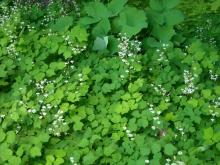
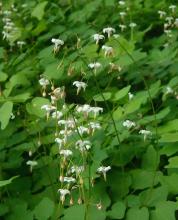
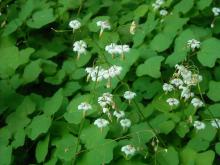
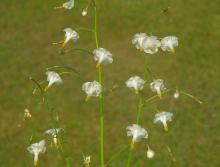
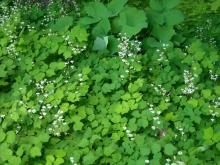
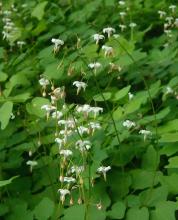
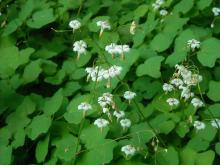
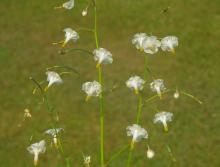
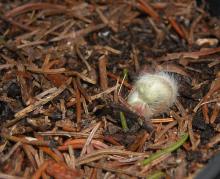
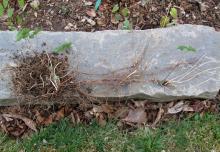
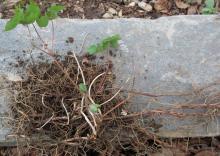
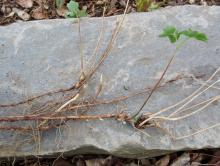
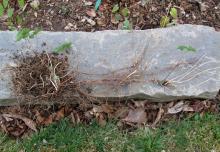
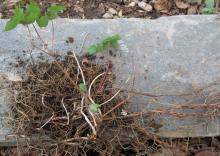
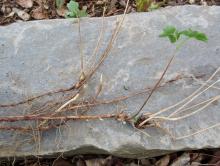
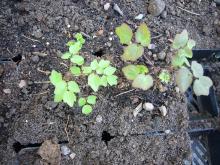
Looks great! I've never tried this genus....I heard they are not that hardy so I have been reticent to try it.